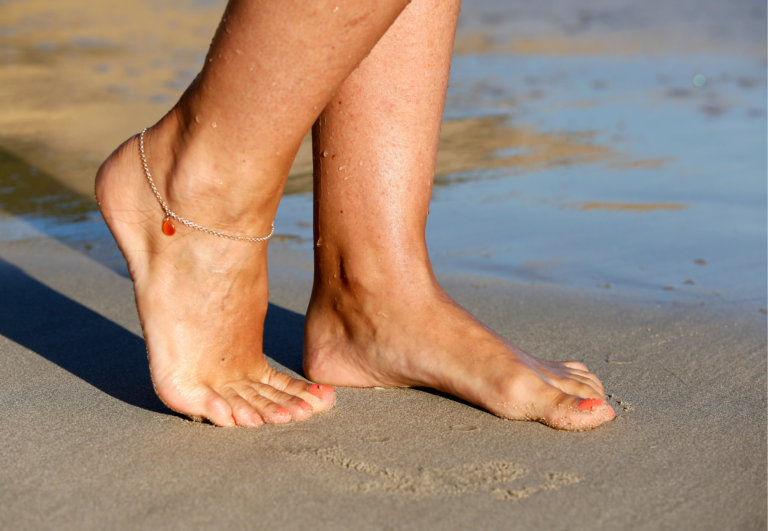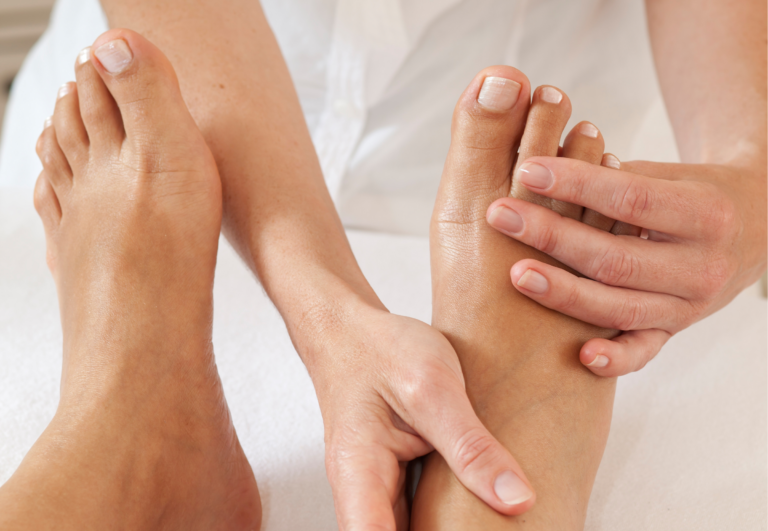How to Relieve Foot Pain at Home: Simple Remedies and Techniques
Experiencing foot pain can be a significant hindrance to daily activities, but there are several home remedies that I’ve found effective in providing relief. From the comfort of your home, you can employ simple strategies such as warm foot baths. These baths are excellent for relaxing the muscles and can even minimize swelling when Epsom salts are added.
Through my experience with toe spacers, I understand the importance of addressing foot pain comprehensively. Engaging in gentle stretching exercises for your calves, Achilles tendon, and the soles of your feet can also be beneficial. Regular stretching can improve flexibility and reduce tension that often contributes to foot discomfort.
In cases of acute pain, I’ve noted that applying a cold pack can help manage inflammation. This treatment can be particularly useful after a long day or an intense workout. These at-home treatments are straightforward and can play an essential role in managing foot pain and improving overall foot health.
Typical Causes of Foot Pain
When dealing with foot pain, it’s crucial to know the common culprits and discern between typical discomfort and signs of more serious conditions. My experience with toe spacers has shown me how important it is to understand your feet.
Identifying Common Foot Conditions
Common foot conditions often stem from overuse, injury, or lack of arch support. These can lead to issues like plantar fasciitis, which affects the plantar fascia ligament, arthritis, or general muscle soreness. People with obesity are more likely to experience foot pain due to the additional pressure on the foot muscles and ligaments. Diabetics may suffer from peripheral neuropathy, a form of nerve pain caused by damaged nerves, leading to poor blood flow and a higher risk of foot problems.
Common Causes of Foot Pain:
- Overuse: Repetitive motion or standing for long periods.
- Injury: Sprains, fractures, or trauma.
- Skin Conditions: Blisters or sores.
- Ligament Strain: Weakened arch support.
- Medical Conditions: Arthritis, neuropathy, obesity.

Recognizing Symptoms of Severe Issues
While it’s common to have foot discomfort after a long day, some symptoms should prompt a visit to a healthcare provider. Seek medical advice if you experience persistent swelling, intense pain, or inflammation that doesn’t improve with rest. Severe symptoms could be a sign of deeper medical conditions, such as diabetes-related neuropathy or a significant injury like a fracture.
Symptoms of Severe Foot Issues:
- Persistent Swelling: Lasting inflammation that might indicate a ligament injury or infection.
- Intense Pain: Could signal a fracture or severe nerve condition.
- Inflammation: If it’s not resolving with rest and ice, it might be more than just overuse.
In my experience, ensuring proper arch support and attending to the health of your foot’s skin and muscles can mitigate minor discomfort, but it’s important to be aware of these alarming symptoms that warrant professional evaluation.
Effective Home Remedies
When it comes to soothing foot pain, simple home treatments can be incredibly effective. I’ve found that using cold and heat therapies, herbal and Epsom salt soaks, as well as massage and gentle exercises, can provide significant relief.
Cold and Heat Therapies
Cold Therapy:
- Use: Reduces inflammation and numbs pain.
- Method: Apply an ice pack to the affected area for 15 minutes at a time.
- Frequency: Repeat every 2 to 3 hours.
Heat Therapy:
- Use: Increases circulation and relaxes muscles.
- Method: Soak feet in warm water for up to 20 minutes.
- Caution: Ensure water is not too hot to prevent burns.
Herbal Soaks and Epsom Salt
Epsom Salt Soak:
- Use: Eases muscle aches and reduces swelling.
- Recipe: Mix 1/2 cup of Epsom salt in a basin of warm water.
- Duration: Soak feet for 15 to 20 minutes.
Herbal Foot Soak:
- Benefit: May provide anti-inflammatory and soothing effects.
- Suggestion: A combination of chamomile tea or lavender oil with warm water.
Massage and Gentle Exercises
Massage:
- Technique: Use lotion or oil to gently rub the entire foot.
- Benefit: Improves circulation and relieves tension.
Gentle Exercises:
- Examples: Toe curls and stretches.
- Goal: Improve flexibility and strength.
These methods, performed regularly, can help manage and alleviate foot pain at home. Remember, these are just general guidelines; listen to your body and consult a professional if you have specific concerns or persistent pain.
Lifestyle Adjustments and Foot Care
Making the right choices for your feet can prevent discomfort and pain. From selecting proper footwear to understanding the benefits of rest, let’s look at some tailored strategies for keeping your feet happy.
Choosing the Right Footwear
When it comes to preventing and treating tired or aching feet, wearing comfortable shoes is crucial. Look for footwear that supports the arches and cushions the heel. If you suffer from frequent foot pain, orthotics or shoe inserts can make a world of difference. Here’s a quick reference for choosing shoes:
- Exercise: Opt for supportive shoes designed for the type of exercising you do.
- Walking/Work: Choose shoes with a comfortable fit, ample arch support, and a cushioned sole.
- Pregnancy: Consider wearing footwear that accommodates swelling and provides extra support.
- Long Periods of Standing: Ensure shoes have a supportive base to alleviate pressure.
Importance of Rest and Elevation
Rest is crucial to manage foot discomfort, especially after a long day of standing or walking. Elevating your feet can help reduce swelling and pain. Follow these steps for effective rest and elevation:
- Take breaks to sit down and rest your feet during the day.
- Elevate your feet above heart level for 15-20 minutes when resting.
- Use pillows or a footstool for elevation to improve blood flow.
Maintaining Foot Hygiene
Good foot hygiene can prevent problems like calluses, corns, and fungal infections. Keep your feet clean and dry, and change your socks daily. Here’s a simple routine to maintain foot hygiene:
- Daily Washing: Clean your feet with soap and water every day.
- Moisturize: Apply lotion to keep the skin from cracking, but avoid between the toes to prevent fungal growth.
- Nail Care: Trim toenails straight across to avoid ingrown toenails.
Remember, if you experience severe pain, numbness, or signs of infection, consult a healthcare provider. For minor aches, these lifestyle changes can often provide relief without the need for pain medications or surgery.
Stretching and Strengthening Exercises
In my experience with foot care, consistent stretching and strengthening are crucial for alleviating foot pain. Let’s jump into specific routines you can do daily.
Daily Stretches for Pain Relief
Big Toe Stretch: Sit down and hold the top of your big toe. Gently pull it towards you until you feel a stretch along the bottom of your foot. Hold for 20-30 seconds, then release. This helps with tension in the ligaments.
Achilles Stretch: Stand arm’s length from a wall with your palms against it. Move one foot back, keeping your heel on the ground, and bend the other knee forward. You’ll feel a stretch in your calves and heel. Hold for 30 seconds and switch.
Strengthening Routines for Foot Health
Toe Splay: While seated, spread your toes as wide as possible, hold for a few seconds, and then relax. Repeat this 10 times to help strengthen the muscles in your feet.
Towel Curls: Place a towel flat on the ground and use your toes to grip and curl it towards you. This exercise is great for your toe muscles and the arches of your feet.
Remember, before starting any new exercise routine, it’s wise to consult with a healthcare professional, especially if you have an existing foot condition.
When to Seek Professional Help
While many cases of foot pain can be managed effectively at home, certain situations require the expertise of a healthcare professional.
Consulting a Podiatrist or Doctor
When dealing with persistent or severe foot issues, it’s crucial to consult a podiatrist or doctor, especially if the pain is affecting your ability to walk or perform daily activities. They can provide a proper diagnosis and recommend treatment plans that may include physical therapy, customized arch support, or night splints for conditions like plantar fasciitis. If you have concerns related to joints, posture, or an open wound that won’t heal, particularly if you have diabetes, don’t hesitate to seek their advice.
Understanding When to Consider Medical Treatment
Timely medical treatment becomes important when you experience symptoms beyond typical soreness. This includes consistent numbness, intense heel pain, or signs of infections like redness and swelling. If you’ve tried over-the-counter pain relievers like ibuprofen or aspirin and the discomfort persists, it might be time for an expert evaluation. Moreover, conditions like ingrown toenails might seem minor but can worsen without proper care. In some cases, surgery may be the most appropriate course of action to alleviate chronic pain or correct structural issues. Always discuss your options with a healthcare provider to determine the best course of action.





